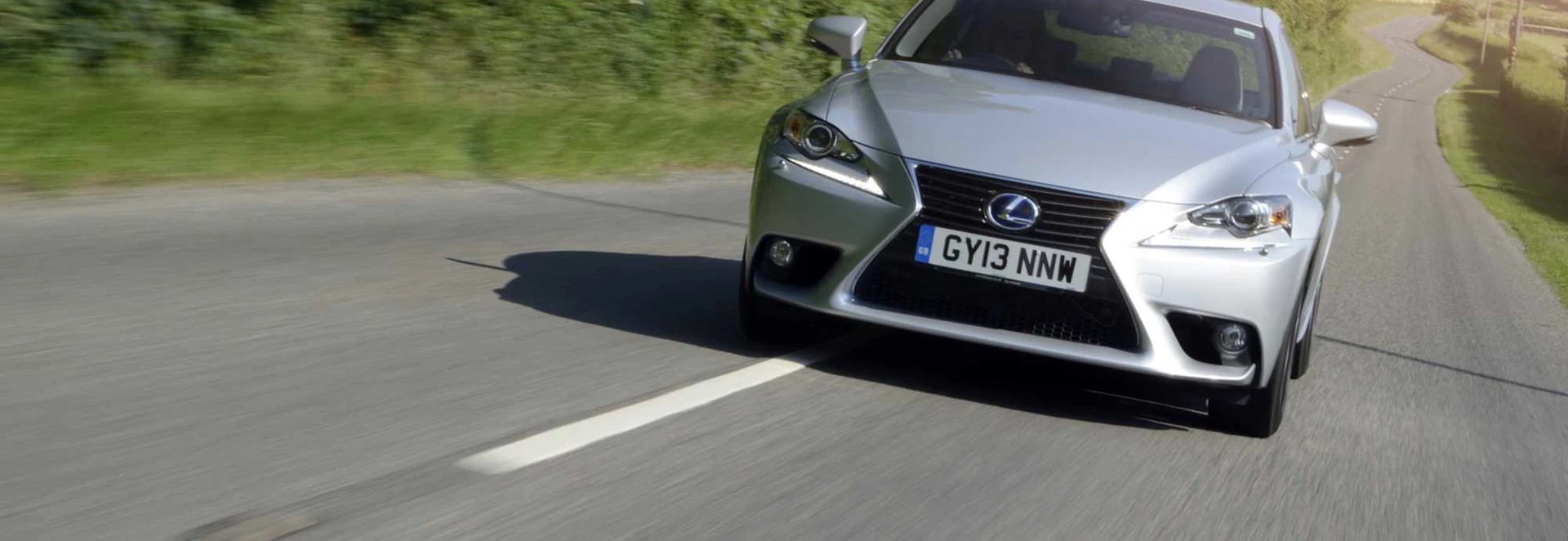The third-generation IS (described by Lexus, like the previous two, as a sports saloon) went on sale in the UK in 2013. The models available here are the IS 250, which has a 205bhp 2.5-litre V6 petrol engine, and the IS 300h, whose hybrid drivetrain consists of a four-cylinder engine of similar size and an electric motor. The total power output of this system is 220bhp. Automatic transmission - six-speed for the 250, CVT for the 300h - is standard. Both versions are rear-wheel drive.
The most obvious rival to the IS is the BMW 3 Series, though the latter has by far the more familiar badge. It's possible that some 3 Series owners don't even know the IS exists.
Performance
If straight-line performance is the only consideration (and, as we're about to find out, it isn't), one IS drivetrain is just about as good as another. The 250 is slightly quicker from 0-62mph at 8.1 seconds, while the more powerful but heavier 300h comes close to that with 8.3 seconds. The hybrid's top speed of 125mph is quite modest compared with the 250's 140mph, but very few owners will find themselves in a situation where this is of any importance.
As is normally the way with Lexus, both engines are very quiet, and it's only when you're accelerating hard that the rather disappointing four-cylinder sound of the 300h becomes fully apparent. The 250's six-cylinder howl is much more evocative.
The decision not to import the 350, or create an equivalent of the very powerful IS F from the previous generation, means that there is no truly quick model in the current range, which some people may find disappointing.
Ride and Handling
Pleasant enough at low speeds, both the ride and handling deteriorate when you start to push harder.
In some ways the Lexus IS is a fine car to drive. The major controls are exceptionally smooth in operation and firm without being heavy. All the seats are very comfortable, and surprisingly enough the turning circle is so small as to shame several much smaller cars, which could not make a 180-degree turn in one go the way the IS can. On the other hand, no previous IS has ever quite matched up to the "sports saloon" description, and the current one doesn't either. Pleasant enough at low speeds, both the ride and handling deteriorate when you start to push harder. In this respect, the IS should be thought of as a small luxury car rather than one with any kind of sporting ability.
Interior and Equipment
The name IS used for this Lexus stands for ‘Intelligent Sport’.
The beautiful instrument design of the original IS is a thing of the past, but today's model nevertheless has an attractive interior. It's also well-equipped: even the cheapest models, called SE, have dual-zone climate control air-conditioning, cruise control, heated and folding door mirrors, automatic headlights, DAB digital radio and Bluetooth connectivity. Other trim levels are called Luxury, F Sport and Premier, the last of these having satellite navigation which is available as an optional extra on all the rest. Leather upholstery is standard on the Premier and optional on the Luxury and F Sport. All 250s have a space saver spare wheel and a 60/40 split folding rear seat. The 300h has neither, and owners have to make do with a tyre repair kit. Unfortunate though this is, it helps with the luggage capacity, which is inevitably limited because of the need to find space for the battery pack. The 250 has a 480-litre boot - the same as a BMW 3 Series saloon - while storage space in the hybrid is 450 litres.
Cost
The outstanding model is the 300h SE, which has official combined fuel economy of 65.7mpg and CO2 emissions of just 99g/km.
As you may already have guessed, there is a tremendous difference between the running costs of the hybrid and the non-hybrid. The outstanding model is the 300h SE, which has official combined fuel economy of 65.7mpg and CO2 emissions of just 99g/km. It's therefore exempt from Vehicle Excise Duty. The SE is the leader because it's fitted with 16-inch wheels. The larger the wheels, and the lower-profile the tyres, the worse the economy and CO2 figures, though even the Premier (which runs on 18s) is impressive with 60.1mpg and 109g/km. Fuel economy for the 250 ranges between 30.7mpg and 32.8mpg, CO2 emissions from 199g/km to 213g/km. Annual VED payments are therefore at least £265, and the BIK ratings are twenty percentage points higher. From the point of view of running costs, therefore, and especially for business users, the hybrid is the one to go for. But it's also worth pointing out that it costs about £3,000 more than the 250, with a starting price of approximately £29,500 rather than just under £27k.
Our Verdict
If we're going to call it a sports saloon, the IS is a bit of a disappointment, since it doesn't fit that description at all. It's not particularly quick, and if you want to have fun driving over country roads, or on track days, you'd better buy something else. As a smallish luxury car it's far more convincing, and the impressively low running costs of the 300h are bound to be appealing.




